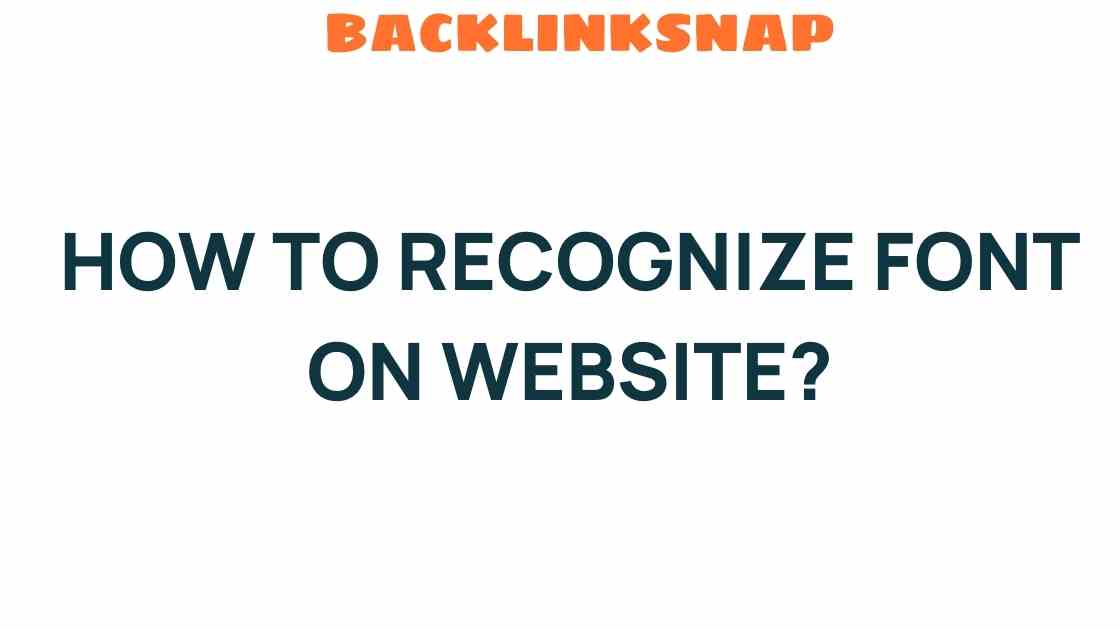Unveiling the Mystery: How to Recognize Font on Websites
In the vast universe of web design, typography plays a pivotal role in conveying a brand’s identity, enhancing user experience, and making content visually appealing. However, as web typography continues to evolve, many designers and enthusiasts find themselves admiring various fonts on different websites, often wondering how to identify fonts they come across. This article aims to guide you through the fascinating world of font recognition, equipping you with the tools and knowledge necessary to pinpoint the fonts you love.
The Importance of Font Recognition in Web Typography
Fonts are more than just decorative elements; they are a critical aspect of web design that can influence readability, accessibility, and even the emotional response of users. When you see a font you admire, whether it’s for its elegance or its modernity, recognizing it can help you incorporate similar styles into your own designs. Font recognition serves as a bridge between inspiration and application, allowing designers to elevate their work through the use of appropriate font styles.
How to Identify Fonts: An Overview
Identifying fonts online might seem daunting, but there are several methods and tools available to help. Here’s a closer look:
- Online Tools: Various websites provide font identification services. These platforms often allow users to upload images of the text they want to recognize.
- Browser Extensions: Browser add-ons can help recognize fonts directly from the web page you’re viewing, making the process quick and effortless.
- Community Forums: Websites like Reddit’s r/identifythisfont can be invaluable for seeking help from fellow typography enthusiasts.
Online Tools for Font Recognition
Several online tools can assist in font recognition. Here are some of the most popular:
1. WhatTheFont
One of the most well-known tools, WhatTheFont allows users to upload an image of the text in question. The platform analyzes the image and suggests similar fonts. It’s user-friendly and provides a vast database of fonts for comparison.
2. Font Squirrel Matcherator
Font Squirrel’s Matcherator functions similarly, allowing users to drag and drop images into its interface. It also provides links to download the recognized fonts, ensuring you can easily apply them in your projects.
3. Identifont
If you don’t have an image but can describe the font characteristics, Identifont can help. By answering a series of questions about the font’s features, you can narrow down your options and identify the font you’re looking for.
4. Fontspring Matcherator
Another great option is Fontspring Matcherator, which is particularly effective for identifying web fonts. It allows users to upload images and get font suggestions, along with links for purchasing or downloading the fonts.
Browser Extensions for Instant Font Recognition
For those who prefer a more integrated approach, browser extensions can streamline the process of identifying fonts. Here are a couple of noteworthy options:
1. Fontanello
Fontanello is a browser extension that provides instant font details right from your web browser. By simply right-clicking on the text, users can access information about the font, including its family, size, and color.
2. WhatFont
WhatFont is another popular extension that makes font recognition a breeze. Users can hover over text to see the font name and style, making it ideal for quick checks while browsing.
Utilizing Community Resources for Font Identification
Sometimes, online tools and extensions may fall short, especially if the font is highly custom or obscure. In such cases, community resources become essential. Websites like Reddit’s r/identifythisfont allow users to post images of fonts they want to recognize. The community can provide quick feedback, often with multiple suggestions. This collaborative spirit can be incredibly helpful, especially for those new to typography.
Understanding Font Styles and Design Elements
When trying to identify fonts, it’s also beneficial to understand various font styles and their design elements. Familiarizing yourself with the terminology can make the identification process smoother. Here are some common font classifications:
- Serif Fonts: Characterized by small lines or embellishments at the ends of their strokes. Examples include Times New Roman and Georgia.
- Sans-Serif Fonts: Clean and modern, sans-serif fonts lack the small lines found in serif fonts. Examples are Arial and Helvetica.
- Script Fonts: These mimic handwritten text, offering a personal touch. Examples include Pacifico and Lobster.
- Display Fonts: Often decorative, display fonts are used for headlines and are not generally suited for body text. Examples include Comic Sans and Impact.
FAQs About Font Recognition
1. Can I identify a font just by looking at it?
Yes, with experience you can learn to recognize fonts by their characteristics. However, using tools or extensions can provide more accurate results.
2. Are there free tools available for font recognition?
Absolutely! Tools like WhatTheFont and Font Squirrel Matcherator are free and user-friendly.
3. How accurate are online font identification tools?
While they are generally reliable, results can vary based on the clarity of the image and uniqueness of the font.
4. Can I use fonts I find online for my projects?
It depends on the font’s licensing. Always check the font’s usage rights before applying it to commercial projects.
5. What should I do if I can’t identify a font?
Try posting in a community forum like Reddit’s r/identifythisfont for help from typography enthusiasts.
6. Do browser extensions work on all websites?
Most browser extensions work well across various websites, but some may not function properly on sites with custom fonts or text images.
Conclusion
Recognizing fonts on websites can be an enriching experience, providing inspiration and practical resources for designers and enthusiasts alike. Armed with the right tools, knowledge of web typography, and an understanding of font styles, you can navigate the world of typography with confidence. Whether you choose to utilize online tools, browser extensions, or community resources, the ability to identify fonts enhances your design skills and broadens your creative horizons. So, the next time you stumble upon a captivating font, don’t hesitate to dig deeper and uncover its identity!
This article is in the category Digital Marketing and created by BacklinkSnap Team




